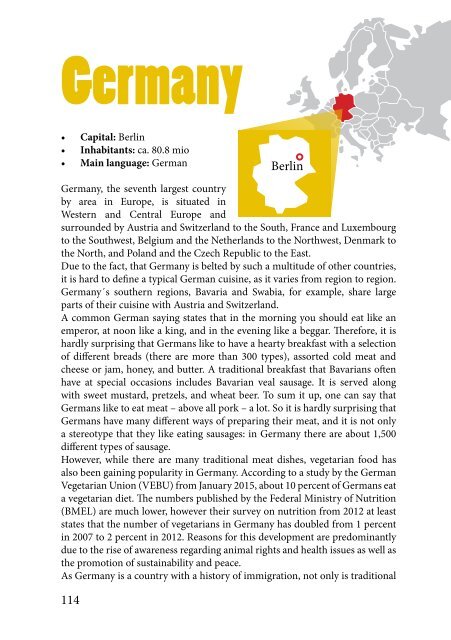Kochbuch_PDF_ohne Beschnitt
Erfolgreiche ePaper selbst erstellen
Machen Sie aus Ihren PDF Publikationen ein blätterbares Flipbook mit unserer einzigartigen Google optimierten e-Paper Software.
Germany<br />
Deutschland<br />
• Capital: Berlin<br />
• Inhabitants: ca. 80.8 mio<br />
• Main language: German<br />
Berlin<br />
Germany, the seventh largest country<br />
by area in Europe, is situated in<br />
Western and Central Europe and<br />
surrounded by Austria and Switzerland to the South, France and Luxembourg<br />
to the Southwest, Belgium and the Netherlands to the Northwest, Denmark to<br />
the North, and Poland and the Czech Republic to the East.<br />
Due to the fact, that Germany is belted by such a multitude of other countries,<br />
it is hard to define a typical German cuisine, as it varies from region to region.<br />
Germany´s southern regions, Bavaria and Swabia, for example, share large<br />
parts of their cuisine with Austria and Switzerland.<br />
A common German saying states that in the morning you should eat like an<br />
emperor, at noon like a king, and in the evening like a beggar. Therefore, it is<br />
hardly surprising that Germans like to have a hearty breakfast with a selection<br />
of different breads (there are more than 300 types), assorted cold meat and<br />
cheese or jam, honey, and butter. A traditional breakfast that Bavarians often<br />
have at special occasions includes Bavarian veal sausage. It is served along<br />
with sweet mustard, pretzels, and wheat beer. To sum it up, one can say that<br />
Germans like to eat meat – above all pork – a lot. So it is hardly surprising that<br />
Germans have many different ways of preparing their meat, and it is not only<br />
a stereotype that they like eating sausages: in Germany there are about 1,500<br />
different types of sausage.<br />
However, while there are many traditional meat dishes, vegetarian food has<br />
also been gaining popularity in Germany. According to a study by the German<br />
Vegetarian Union (VEBU) from January 2015, about 10 percent of Germans eat<br />
a vegetarian diet. The numbers published by the Federal Ministry of Nutrition<br />
(BMEL) are much lower, however their survey on nutrition from 2012 at least<br />
states that the number of vegetarians in Germany has doubled from 1 percent<br />
in 2007 to 2 percent in 2012. Reasons for this development are predominantly<br />
due to the rise of awareness regarding animal rights and health issues as well as<br />
the promotion of sustainability and peace.<br />
As Germany is a country with a history of immigration, not only is traditional<br />
• Hauptstadt: Berlin<br />
• Einw<strong>ohne</strong>r: ca. 80,8 Mio<br />
• Hauptsprachen: Deutsch<br />
Deutschland, das flächenmäßig siebtgrößte Land in Europa liegt in West- und<br />
Mitteleuropa. Es grenzt im Süden an Österreich und die Schweiz, im Südwesten<br />
an Frankreich und Luxemburg, im Nordosten an Belgien und die Niederlande,<br />
im Norden an Dänemark und im Osten an Polen und die Tschechische<br />
Republik.<br />
Die Tatsache, dass Deutschland von einer Vielzahl von anderen Ländern umgeben<br />
ist, macht es schwierig, eine typisch deutsche Küche zu definieren, da sich<br />
diese von Region zu Region unterscheidet. Bayern und Schwaben zum Beispiel<br />
teilen große Teile ihrer Küche mit Österreich und der Schweiz.<br />
Ein bekanntes deutsches Sprichwort lautet: ”Frühstücke wie ein Kaiser, iss zu<br />
Mittag wie ein König und zu Abend wie ein Bettler.” Daher ist es nicht erstaunlich,<br />
dass die Deutschen gerne herzhaft frühstücken, mit einer Auswahl<br />
verschiedener Brotsorten (es gibt mehr als 300 verschiedene Sorten), verschiedenerlei<br />
kaltem Fleisch und Käse oder Marmelade, Honig und Butter. Ein<br />
114 115


